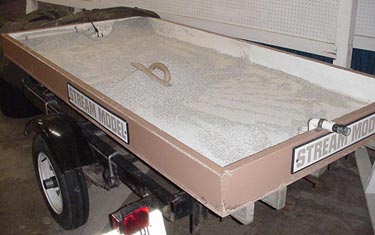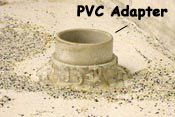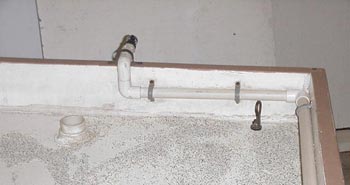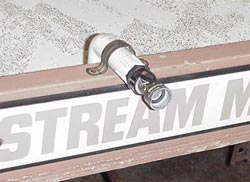Building a Stream Table

To see how a stream table works, visit River
Basics at: http://www.urbanext.uiuc.edu/rivers/basics_03.cfm
General Model Stream Materials
List
(Additional or fewer parts may
be needed, if building plans are changed)
Total
cost approximately $300
1 |
4’ x 8’ 5/8" exterior
plywood
|
3 |
8’ x 2" x
6" pine boards (untreated) These boards must
be sound – any loose knots or cracks will allow
leaks when the box is in use.
|
1 each |
PVC cleaning compound
and PVC sealant |
1 cartridge |
Caulking type liquid
glue
|
1 pound |
#6 x 2" dry wall
screws
|
1 |
100 foot outdoor use
electric extension cord (optional) |
1 |
15’ length of 1
1/2" PVC pipe
|
1 |
10 gallon plastic feed
tub for reservoir
|
1 |
3 gallon heavy duty bucket
for filter bucket
|
1 |
Large plastic bucket
for carrying water (optional)
|
1 |
3/10 HP electric sump
pump
|
1 |
¾ inch threaded
PVC connector
|
6 |
right angle elbows to
fit PVC pipe
|
1 |
¾" water
valve that would attach to male end of garden hose
|
12 |
5/8" pipe straps
|
1 |
8’ section of flexible
garden hose (will be cut) |
4 sq ft |
Window screening for
filtering sand
|
1 each |
Male and female garden
hose ends |
2 |
Boat drain plugs |
4 |
Automotive jack stands.
Two of these should be the notched type, which allow
fine adjustment of box slope. Alternately, small
wood shims can be used to adjust elevation.
|
1 gallon |
Polyurethane paint (boat
paint would be best)
|
1 cartridge |
Clear silicone sealant
|
2 |
Plastic grain scoops
for moving sand (these are available at farm supply
sores)
|
1 |
Outdoor use multiple
outlet power strip with on/off switch. |
100 pounds |
Sand - we used plastic
sand, and our distributor is.
Composition Material Inc., 1375 Kings Highway,
Fairfield CT 06430
Ph: 203/384-6111
|
1 |
50’ garden hose
to fill reservoir (optional)
|
Building the Stream Table
(Refer to pictures of stream table
as an additional guide)
- Miter cut two sections of 2" x 6" to fit
flush with the ends of the plywood. Miter cut two sections
of 2" x 6" to form the table sides. Miter
all ends 45 degrees. Join together to form ends and
sides of table, using wood screws and liquid nails.
Attach to plywood by aligning sides, applying liquid
nails to the edge that will attach to the plywood,
and drilling wood screws through the bottom of the
plywood into the 2" x 6"s. The box must
be carefully built so that it will be waterproof when
finished.
- Apply sealant to inside of all seams.
- Using a 2" hole saw, drill the drain hole on
one end of the table bottom.
- Place PVC adapter into hole, and apply sealant on
outside of adapter where it contacts the wood. For higher
water retention, place additional adapters into existing
adapter. (A removable piece of PVC may be used in place
of using a permanent fixture.)

- Using properly sized hole saw, drill two holes for
placing drain plugs. Each hole should be approximately
4 inches from the corners of the stream table, on
the same end as the main drain hole. (This step may be
skipped if using removable PVC in the main drain hole.)

- Apply at least 3 coats of paint to the box (may need
to be repainted every other year).
- When using table, use jack stands to support table.
(Other methods of support may be used, such as a
boat trailer or sawhorse, depending on your needs. The
boat trailer allos the stream table to be mobile so it
can go from location to location.) Place table on slight
slope so that water will flow from outlet end to drain.
Instructions for Building Pump
and Reservoir System
( Refer to pictures for additional guidance) Many
modifications can be made, based on your needs.
- Place ¾" male threaded PVC connector to
shutoff valve. This will be attached to the stream table
in a later step.

- Cut ¾" PVC pipe to fit inside
dimensions of table and join to right angle elbows as
illustrated.

- Clean ends of PVC where connections will
be made. Apply sealant and attach elbows as illustrated.
Attach threaded PVC connector to rest of pipe, so that
it will sit on top edge of stream table as shown.
- Using ¾" pipe
straps, place pipe on box sides near the top edge as
shown in pictures.
- Place sand at end of table where water
will outlet out of pipe.
- Cut 3 foot section of flexible
garden hose. Where needed, attach male and or female
hose connections (need one of each).
- Attach male end
of hose to shutoff valve.
- Attach female hose connector
to the sump pump
- Drill several ½" holes
in the side of the filter bucket.
- Cut a square of window
screening that is large enough to cover all the holes.
Glue in place inside the bucket using lots of silicone
sealant.
- Place filter bucket under drain to collect
sand that goes through drain.
- Place sump pump inside
10 gallon feed tub
- Fill reservoir tub three-fourths full
of water.
- Attach outdoor use power strip to sump pump.
Make sure the switch is off.
- Plug power strip to an extension
cord or power outlet. Check valve to make sure it is
at least partially open, then turn switch on power
strip on.
- Adjust flow using valve to desired flow. Check
for leaks.
Streambank Table
Presentation - General Outline
Introduction
- How are rivers and stream used?
- Water supply, wildlife, recreation, electricity,
transportation
- Management of rivers must look at interactions
of all used
- Why are rivers an important transportation
link?
- Economical way to transport bulk materials (coal,
grain)
River/Stream formation
- Illinois streams
- Many formed after the last glaciation
approximately 10-12,000 years age.
- Glacier destroyed
previous stream system (Mississippi River was in
present location of lower Illinois River).
- River formation
- Small areas of surface runoff will concentrate
into small streams.
- These streams will flow together into
larger streams and rivers.
- Rivers and streams will form
along lowest possible course.
- River will start out narrow,
and widen and deepen over time.
- Formation of delta, floodplain,
meanders.
- Delta
- Channel will sway back and forth across delta.
- Side channels (distributaries) evident
- Delta forms due to slowing of water, causing sediment
deposition.
- Floodplain
- Low lying, flat area formed next to stream/river
channel.
- Will have water flow during high water events.
- Meanders
- Curves will form naturally in rivers and streams,
especially if area is fairly flat
- Natures way of slowing water down, decreasing erosion
potential.
- Flow through curve will erode on outside of curve
(where fastest flow is), will deposition occurring
on inside of channel.
- Flow moves through curve like a corkscrew.
Channelization
- Created by artifically straightening channel
- Increases water speed
- Lack of vegetation on banks create severe erosion
potential
- Nature will slow speed of water by creating curves,
reverting to more natural channel.
Natural Channel
Changes
- Occurs over thousands of years
- Curves become too big, water moves too slowly-
creates “out
of balance" condition in that section of stream
- River re-creates equilibrium by cutting out curve-
short-cutting channel
- Oxbow or Horseshoe lake formed
Levees and Dams
- Dam is for holding back water all the time (pond, lake).
- Levee
is for holding back water from floodplain during high
water events.
- Dam constructed with heavy clay.
- Levee constructed with
material dredged from river (clay, silt, sand).
- During
prolonged floods, levee can fail (starting on the side
opposite from the stream). from water seepage.
Surface Runoff
- More runoff occurs today in rural and urban areas because
of:
- More areas where rain can’t soak into the ground
(parking lots, roads, buildings, increase in underground
drainage tiles).
- Change in vegetation (lawns and field crops instead
of prairie grasses or trees).
- More runoff means more water, and faster streams, which
in turn creates
- Increased streambank erosion.
- More sedimentation in streams in lakes.
Ways to Reduce Streambank Erosion
- Planting of trees along a stream
bank.
- Use of other structural conservation practices that
divert the fast water away from the outside curve to
more of the center of the stream.
- Planting of grasses, trees and shrubs just outside
of the stream bank to slow water before it enters the
stream.
- Use of large rock (rip rap) to control erosion- used
in urban areas next to high value areas.
Return to Resources | Return to Teacher's Guide |
